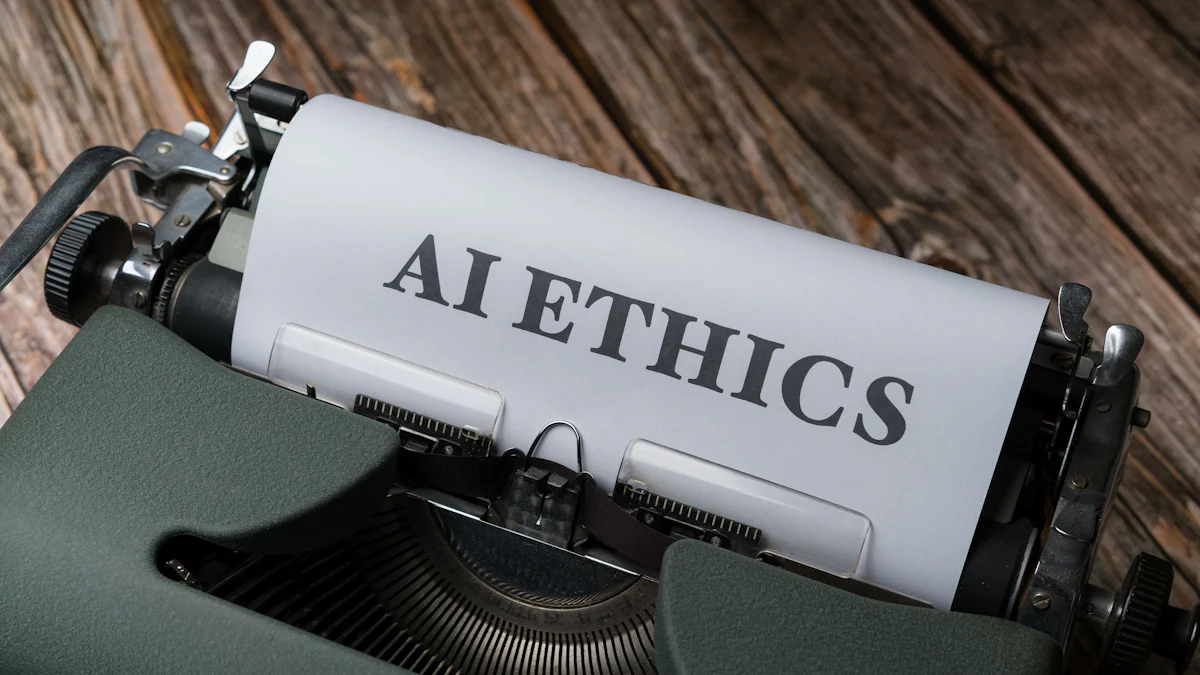Can AI Be Trained to Be Unbiased?

Artificial Intelligence (AI) has become a cornerstone of modern technology, transforming industries and daily life. However, AI systems often reflect biases present in their training data or algorithms. This bias can lead to unfair outcomes, affecting everything from hiring processes to healthcare decisions. Addressing bias in AI systems is crucial because it ensures fairness and accuracy. You might wonder why this matters. Well, biased AI can amplify negative effects on a large scale, as seen in various real-world applications. By focusing on AI Training, we can work towards creating more equitable and unbiased AI solutions.
Understanding Bias in AI
Types of Bias in AI
AI systems can exhibit different types of bias. Let's explore these biases to understand how they affect AI applications.
Data Bias
Data bias occurs when the data used to train AI models is not representative of the real world. If you feed an AI system with biased data, it will likely produce biased outcomes. For instance, if a dataset lacks diversity, the AI might not perform well for all groups. This kind of bias often reflects historical and societal inequalities. You can think of it as a mirror reflecting the imperfections of the data it learns from.
Algorithmic Bias
Algorithmic bias arises from the design of the algorithms themselves. Sometimes, the way an algorithm processes data can lead to unfair results. This bias can occur even if the data is unbiased. You might wonder how this happens. Well, algorithms can have built-in assumptions that favor certain outcomes over others. These assumptions can inadvertently lead to biased decisions.
Human Bias
Human bias creeps into AI systems through the people who design and train them. When developers bring their own biases into the process, AI systems can inherit these biases. You might not realize it, but human biases can subtly influence the choices made during AI development. This includes decisions about which data to use and how to interpret results.
Examples of Bias in AI Applications
Bias in AI isn't just theoretical. It has real-world implications across various applications.
Facial Recognition
Facial recognition technology often struggles with accuracy across different demographic groups. You might have heard about cases where these systems misidentify individuals, especially those from minority groups. This happens because the training data lacks diversity, leading to biased outcomes. Such inaccuracies can have serious consequences, like wrongful arrests or privacy violations.
Hiring Algorithms
Hiring algorithms aim to streamline recruitment processes, but they can perpetuate existing biases. If you rely on these algorithms, you might unknowingly favor candidates who resemble past hires. This occurs because the algorithms learn from historical hiring data, which may contain biases related to gender, race, or educational background. As a result, qualified candidates from diverse backgrounds might get overlooked.
Predictive Policing
Predictive policing uses AI to forecast criminal activity, but it can reinforce existing biases in law enforcement. You might think this technology helps prevent crime, but it often targets communities already under heavy surveillance. This happens because the algorithms rely on historical crime data, which may reflect biased policing practices. Consequently, predictive policing can lead to over-policing in certain areas, perpetuating a cycle of bias.
Understanding these biases is crucial for developing fair and equitable AI systems. By recognizing the sources and impacts of bias, you can work towards creating AI solutions that benefit everyone.
Causes of Bias in AI
Data Collection Issues
Lack of Diversity in Data
You might wonder why AI systems often fail to treat everyone equally. One major reason is the lack of diversity in the data used to train these systems. When data lacks representation from all groups, AI models can become biased. For example, facial recognition technology often misgenders women of color. This happens because the training data predominantly features lighter skin tones. As a result, the AI struggles with accuracy for diverse populations. Ensuring diverse data sets can help mitigate this issue.
Historical Biases in Data
Historical biases in data also contribute to AI bias. You see, AI learns from past data. If that data contains biases, the AI will likely replicate them. Consider predictive policing software, which has shown bias against African-Americans. This bias stems from historical crime data that reflects biased policing practices. By relying on such data, AI systems perpetuate systemic racism. To combat this, you need to critically assess and refine the data used in AI training.
Algorithm Design Flaws
Inherent Bias in Algorithms
Algorithm design plays a crucial role in AI bias. Sometimes, algorithms have built-in assumptions that lead to unfair outcomes. For instance, hiring algorithms might favor candidates who resemble past hires. This occurs because the algorithms learn from historical hiring data, which may contain biases related to gender, race, or educational background. As a result, qualified candidates from diverse backgrounds might get overlooked. You can address this by designing algorithms with fairness in mind.
Lack of Transparency
Transparency in algorithm design is essential for reducing bias. When algorithms operate as "black boxes," you can't easily understand how they make decisions. This lack of transparency can hide biases and make it difficult to correct them. For example, healthcare algorithms have shown racial bias, reducing the number of Black patients needing additional care. By promoting transparency, you can identify and address biases more effectively. This involves making algorithmic processes clear and understandable to all stakeholders.
Understanding these causes of bias is vital for creating fair AI systems. By addressing data collection issues and algorithm design flaws, you can work towards developing AI solutions that benefit everyone.
AI Training and Methods to Mitigate Bias

Creating unbiased AI systems requires a thoughtful approach to AI Training. You can take several steps to improve data quality and implement algorithmic solutions that help mitigate bias.
Improving Data Quality
Diverse and Representative Data Sets
To reduce bias, you need to start with diverse and representative data sets. When your data reflects the real world, AI models perform more fairly across different groups. Imagine training an AI system with data that includes a wide range of ages, ethnicities, and genders. This diversity helps the AI make accurate predictions for everyone. A data-centric approach ensures that the AI doesn't favor one group over another. By prioritizing inclusivity in your data collection, you lay the foundation for unbiased AI.
Regular Data Audits
Regular data audits play a crucial role in maintaining data quality. You should routinely check your data for any signs of bias or imbalance. Think of it as a health check-up for your data. These audits help you identify and correct any issues before they affect your AI models. By keeping your data in check, you ensure that your AI systems remain fair and accurate over time. Regular audits also promote transparency, allowing you to understand how your data influences AI outcomes.
Algorithmic Solutions
Fairness Constraints
Incorporating fairness constraints into your algorithms can help mitigate bias. These constraints guide the algorithm to make decisions that are fair to all groups. You can think of them as rules that ensure the AI treats everyone equally. By embedding fairness into the algorithm design, you reduce the risk of biased outcomes. This proactive approach helps create AI systems that align with ethical standards and promote equity.
Bias Detection Tools
Bias detection tools are essential for identifying and addressing bias in AI systems. These tools analyze the AI's decisions to spot any unfair patterns. You can use them to monitor your AI models and ensure they operate fairly. By leveraging these tools, you gain insights into how your AI makes decisions and where bias might occur. This knowledge empowers you to take corrective actions and improve the overall fairness of your AI systems.
"AI governance tools ensure that AI technologies adhere to ethical and legal standards, preventing biased outputs and promoting transparency."
By focusing on AI Training and implementing these methods, you can work towards creating AI systems that are both fair and effective. Addressing bias at every stage of the AI development process is key to achieving this goal.
The Role of Regulation and Policy
Regulation and policy play a crucial role in shaping how AI systems operate. They ensure that AI technologies adhere to ethical standards and protect individuals from biased outcomes. Let's explore the current frameworks and proposed policies aimed at creating unbiased AI.
Current Regulatory Frameworks
GDPR and AI
The General Data Protection Regulation (GDPR) in the European Union sets a high standard for data protection and privacy. It impacts AI by requiring transparency in how personal data is used. You might wonder why this matters. Well, GDPR ensures that AI systems respect user privacy and provide explanations for their decisions. This transparency helps identify and mitigate bias, promoting fairness in AI applications.
U.S. AI Initiatives
In the United States, various initiatives aim to regulate AI technologies. These initiatives focus on promoting innovation while ensuring ethical AI development. For instance, the National Institute of Standards and Technology (NIST) provides guidance on understanding biases in AI. NIST emphasizes the importance of considering societal influences on technology development. By doing so, it encourages organizations to create AI systems that are fair and equitable.
Proposed Policies for Unbiased AI
Ethical Guidelines
Ethical guidelines serve as a foundation for developing unbiased AI. They provide a framework for addressing bias at every stage of AI development. You can think of them as a moral compass guiding AI researchers and developers. The AI Fairness 360 Toolkit offers a comprehensive set of metrics to test for biases in datasets and models. By following these guidelines, you can ensure that AI systems operate ethically and fairly.
Accountability Measures
Accountability measures hold AI developers and organizations responsible for their systems' outcomes. These measures promote transparency and encourage continuous improvement. You might ask, how does this work? Well, accountability involves regular audits and assessments of AI systems. By implementing these measures, you can identify and correct biases, ensuring that AI technologies benefit everyone.
"Ensuring fundamental rights and freedoms are protected by allowing for appropriate human supervision and intervention."
Regulation and policy play a vital role in creating unbiased AI. By understanding current frameworks and supporting proposed policies, you can contribute to developing AI systems that are both ethical and effective.
The Role of Human Oversight
Human oversight plays a crucial role in ensuring AI systems operate fairly and ethically. You might wonder why this is important. Well, humans can provide the necessary checks and balances that machines lack. Let's dive into how human intervention and training can help mitigate bias in AI.
Importance of Human Intervention
Monitoring AI Decisions
You need to keep an eye on AI decisions to ensure they align with ethical standards. By actively monitoring AI outputs, you can catch any biases early on. Think of it as a quality control process. Regular checks help maintain the integrity of AI systems. This vigilance ensures that AI applications serve everyone fairly and accurately.
Correcting Biases
When you spot biases in AI decisions, it's essential to take corrective action. You have the power to adjust algorithms and data inputs to reduce unfair outcomes. This proactive approach helps create AI systems that are more equitable. By addressing biases head-on, you contribute to developing AI technologies that benefit all users.
Stuart Russell, a renowned AI expert, emphasizes the need for "safety brakes" in AI systems. He suggests that systems breaking regulatory rules should be recalled. This highlights the importance of human intervention in maintaining ethical AI practices.
Training and Awareness
Educating AI Developers
Educating AI developers is key to creating unbiased AI systems. You can equip developers with the knowledge and skills needed to recognize and address biases. Training programs should focus on ethical AI development and the impact of biases. By fostering awareness, you empower developers to build fairer AI solutions.
Promoting Ethical AI Practices
Promoting ethical AI practices involves creating a culture of responsibility among developers and organizations. You can encourage the adoption of ethical guidelines and accountability measures. This commitment to ethics ensures that AI systems operate transparently and fairly. By championing ethical practices, you help shape a future where AI technologies enhance society.
Yoshua Bengio, a leading figure in AI, warns of the risks associated with AI, including discrimination and loss of control. His insights underscore the need for human oversight to guide AI development responsibly.
Human oversight is vital for ensuring AI systems remain fair and ethical. By monitoring decisions, correcting biases, and promoting education and ethical practices, you can help create AI technologies that serve everyone equitably.
Future Directions in AI Bias Mitigation

Emerging Technologies
Explainable AI
You might wonder how AI makes its decisions. Explainable AI (XAI) aims to shed light on this mystery. It focuses on creating AI systems that can explain their reasoning in a way you can understand. This transparency helps you trust AI decisions and spot any biases. Imagine an AI system that not only gives you a result but also explains how it got there. This clarity allows you to identify and correct biases, ensuring fair outcomes. As XAI continues to evolve, it promises to make AI more accountable and trustworthy.
AI Ethics Research
AI ethics research plays a crucial role in shaping the future of unbiased AI. Researchers explore the ethical implications of AI technologies and develop guidelines to address bias. You might ask, why is this important? Well, ethical research helps ensure that AI systems align with societal values and promote fairness. By understanding the impact of AI on different communities, researchers can create solutions that benefit everyone. This ongoing research is vital for developing AI technologies that are both ethical and effective.
Collaboration and Innovation
Cross-Disciplinary Approaches
Tackling AI bias requires collaboration across various fields. Cross-disciplinary approaches bring together experts from different domains to address bias comprehensively. You might think of it as a team effort. By combining insights from computer science, sociology, and ethics, you can develop well-rounded solutions. This collaboration fosters innovation and helps create AI systems that are fair and inclusive. By working together, you can tackle complex challenges and drive meaningful change in AI development.
Industry and Academic Partnerships
Partnerships between industry and academia play a pivotal role in advancing AI bias mitigation. These collaborations leverage the strengths of both sectors to develop cutting-edge solutions. You might wonder how this works. Well, academic researchers provide theoretical insights, while industry experts offer practical applications. Together, they create a powerful synergy that drives progress in AI bias mitigation. By fostering these partnerships, you can accelerate the development of unbiased AI technologies and ensure they benefit society as a whole.
"Diverse AI teams can help in identifying and mitigating bias issues before the release of AI solutions into production."
In conclusion, the future of AI bias mitigation lies in embracing emerging technologies and fostering collaboration. By focusing on explainable AI, ethical research, cross-disciplinary approaches, and industry-academic partnerships, you can work towards creating AI systems that are fair, transparent, and beneficial for all.
Unbiased AI is crucial for fairness and equity in technology. You can achieve this by focusing on diverse data collection and responsible AI development. Here are some key steps:
Diverse Data: Ensure your data represents all groups to reduce bias.
AI Governance: Implement governance to maintain fairness and inclusion.
Human Oversight: Regularly monitor AI decisions to catch biases early.
"Promoting diversity in AI teams helps identify and mitigate biases effectively."
You play a vital role in advancing unbiased AI. Keep pushing for research and development to create fairer AI systems.
See Also
Creating Ethical Artificial Intelligence Models
Ethical Dilemmas in AI for Human Replication
Is AI-Produced Art Truly Artistic?
